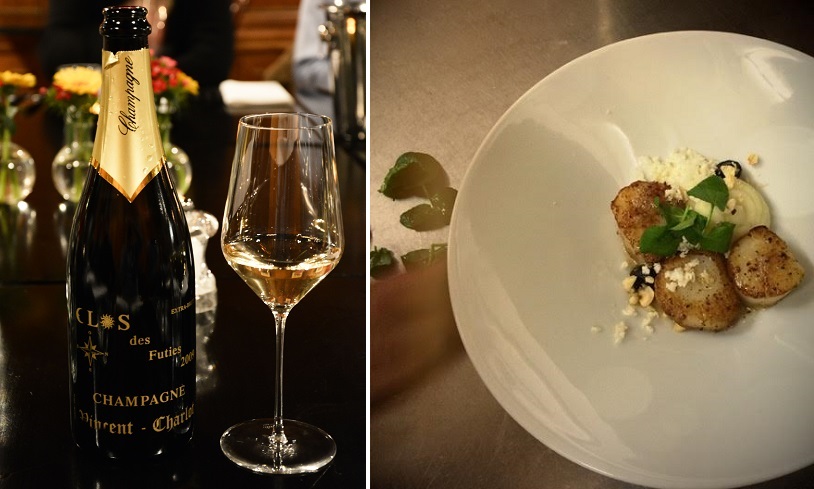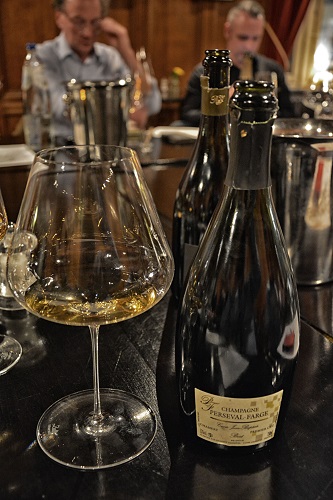
The Terroir Dinner
Terroir...
T
erroir has become, of course, quite the “buzzword” In the fine wine world. Exact definitions can be elusive. It's all about the location of the vines, the type of soil, the life in the soil, fossils, micro-climate, a sea breeze, but most important the work in the vineyard and respect for nature. My appreciation for growers producing organic and/or biodynamic champagne just started in 2015. The biodynamic champagnes I tasted before often had that strange band-aid, Mercurochrome or glue aroma that really puts me off. Times have changed. Those sometimes awkward and faulty experiments of the past have paved the way for excellent, expressive champagnes with lots of character. Most of the wines that I've tasted are true gastronomic champagnes, just begging to be paired with food. So we did just that!
We teamed up with chef and good friend Filip Bossuwé from restaurant FoyerNTGent in Ghent, Belgium to present a Terroir Champagne Dinner. Chef Bossuwé is an expert on creating food pairings with champagne. He works with fresh, mostly local, seasonal products, with a cooking style not informed by trendy Nordic cuisine or molecular magistry but pure, old-school Escoffier-influenced food with a personal touch.

We kicked off with a fabulous Le Magnum vintage 2006 Blanc de Blancs from Ulysse Collin, dégorgé in 2012. Being familiar with this wine and vintage in the 75 cl bottle, I'd thought it would make a fine aperitif, but in magnum, this rare wine seemed richer, perhaps too rich for my taste to be served as an aperitif. It's a lesson we learn over and over: the same cuvee will express itself differently in different bottle formats. I was shocked at how much more incredibly rich and yeasty the wine seemed than its 75cl counterpart –it reminded me in many ways of Selosse's fabulous 1999 vintage.
Speaking of Selosse, Olivier Collin is one of the most talented disciples of Champagne-sensei Anselme Selosse, and as with Anselme's wines, there is a tremendous, complex, stony, chalky and smoky minerality together with old cheese (mimolette) notes, yet there is also finesse and also a floral elegance to it. After a longer while in the glass it showed warm spiced notes of lovage and Garam Masala. The mouthfeel is deep and vinous and really wants to accompany food. On the palate you get creamy citrus fruit, peach, and lager-beery fermented notes together with green apple, salted lemon and vanilla on the mid palate. The long finish has a deep Meursault-ish character with smoke, tobacco and a very refined acidity with lemon pith and pomelo. I was honored to taste this masterpiece. .
Our second apero was La Rue des Noyers 2012 from Benoît Déhu. This lovely single parcel and single variety Pinot Meunier needed some time to open up. To be honest, tasting this immediately following the Ulysse Collin was not a great idea. Putting tasting order to one side, the champagne showed very well. After decanting - and bringing it closer to room temperature - it started showing its beauty but it remained tight. On the nose you get young apple, a hint of oxidation, nuttiness, peach, crushed rocks, linden blossom and a touch of roasted coffee. It is intense, focused and very linear. On the palate you get grapefruit, yuzu, lemon zest, linden blossom and Thai basilicum. This vintage displays more vegetal tones than the 2011, a vintage known for its green notes. The finish offers crystallized citrus fruits, lime and a chalky minerality. This wine is very young but imploding with potential. Even though I like the 2011 more because of its richness, depth, concentration and layered complexity I think that with time the 2012 will acquire a Prévost-like expression. All elements are there to be a vin de garde.

I tasted Clos des Futies 2009 together with vigneron Vincent Charlot and I was simply blown away, so It was an obvious choice to have this beauty at the Terroir Champagne Dinner. Cépage: 50/50 Pinot Noir and Chardonnay from a clos located in Epernay. Vincent works organically and his vineyards are among the most beautiful and well-tended that I've come across in Champagne. Now the wine: the nose reminds me of a tropical, fat but mineral intense Riesling with lovely ripe mango, peach, persimmon, blood orange, hibiscus syrup, fruity olive oil and minerality, yet also with a beguilingly sweet scent of lobster. The luminous gold-kissed-with red color and fat tears give away that this is a special wine. The mouthfeel is concentrated, silky, really palate-caressing. And what we perceive as “sweet” can actually be the sweetness of ripe fruit: this wine is low dosage but brimming with ripe tropical fruits, peach and delicious juicy greengage plums. Overarching all is structure and acidity and minerality.
Filip - the chef of the evening - had the advantage of having tasted this wine with me and Vincent beforehand, so he already had a dish in mind. He came up with scallops, cream of cauliflower, hazelnut and watercress, and the pairing was spot-on. The sweetness of those perfectly seared scallops paired with this wine was a sensual experience.

Next in line was Roses de Jeanne La Haute Lemblee 2011. The wines of Cédric Bouchard are simply hors categorie, some of the best champagnes you can find. I was thrilled to receive a bottle thanks to Ine Goossens from Just Add Wine who specializes in terroir and organic wines. Whoff, what a peculiar aroma! It's volcanic, exponentially mineral, dried lemon peel, fern. On the palate you get lime, lemon, unripe nashi pear and silex. An electrifying finish with pink Himalayan salt, smoke and toast has to make place for resonating lemon, gooseberry and lime. Tight and still so very very young, but for some guests it was the wine of the evening. The symbiosis with Atlantic cod, parsnips and marinated shiitake was very nice but what completely topped it off was an exquisitely delicious croquette of spider crab. Truly memorable.

Jardin de La Grosse Pierre by Benoît Lahaye is quite something. It's a blend of Pinot Noir, Pinot Meunier, Pinot Blanc, Chardonnay, Arbanne, Chasselas, Petit Meslier , Gros Plant, Teinturier and maybe other varieties. It's complantée which means that the varieties are mixed planted across the vineyard. I really wanted to have this wine for this dinner because of the fabulous 2009: a deeply vinous, unusual champagne with aromas and flavors of squid ink, olive-like bitterness and a huge finish. The 2010 was a completely different wine. I was actually a bit disappointed. It would have been better served as an aperitif. The nose was elegant with sweet melon, crême Isigny, dill and minerals. This is an easygoing wine with a medium finish. The combination with slow-cooked veal neck, andives, cantharelles and dried je-ne-sais-quoi wasn't good. The heavy flavors overpowered the light wine. Unfortunately there was some miscommunication because the chef didn't count in an extra course. He had prepared this dish to go with the next wine, which would have been great. It was my fault but after tasting the next wine the guests forgave me, hehe.

And now le moment suprême: Jacques Selosse Substance, 100% Chardonnay from Avize, made with the Solera technique and comprised of vintages dating back to 1986. Anselme personally gave me a bottle for the tasting and recommended this particular disgorgement (3rd of July 2008). Look at that color of heavenly nectar and very fat tears! The Zalto Burgunder glassware was just perfect for this wine. The aroma completely surprised me. I expected an oxidative-style wine but this reminded me of Charlie... This is so rich with tons of layers of candied fruit, fig, wax, foie gras, deep mature Chardonnay, honey, baked apple tobacco and redcurrant jam and blueberry cake. After longer in the glass it showed subtle animal aromas and old Montrachet complex funk, spices, foliage and Romanticism. *Blinks away a tear* Wow, breathtaking! The texture of this wine is so vinous, concentrated and oily like Sauternes. On the palate you get deep cognac tones, baked apple, fondant chocolate, quince cheese, hazelnut cream. So many layers of complexity with tertiary leathery notes and soy-like savory-umami flavors. On the mid palate you get an exquisite mineral complexity. The huge finish is so Burgundy-like, packed with wood spices, caramelized shallots, tobacco, buttercream, toffee and grilled porcini mushrooms. I can imagine that the combination with that veal neck would have been ethereal but the cheeses - old Comté and Beaufort - did not disappoint.

Time for a surprise: not biodynamic,but HVE certified; 55% Chardonnay, 30% Pinot Noir and 15% Pinot Meunier from Chamery and a blend of vintages 1999, 1998 and 1996 vinified in oak barrels... It's Perseval-Farge cuvée Jean-Baptiste. Yes, it was a risk to serve this after the illustrious Selosse, but I wanted so much to share this wine because it was a very nice discovery. Deep old golden color with very fine bubbles and pretty tears on the glass. Aromatic nose of toasted almond, nougat, preserved apricots, brandy, floral Ethiopian coffee, pistachio, heather honey, quince, smoky peat, potpourri, wax, pineapple and dried figs. The mouthfeel vinous but still focused. On the palate we get mature notes of apple, dried apricots, quince, floral coffee, fig, honey, wax and smokiness, and on the mid palate, there's orange zest. The long finish is nutty, oaky and has a lovely citrus-y acidity that makes your mouth water.

Last but not least, a vieux millésime: Desbordes-Amiaud 1989. This is 100% Pinot Noir from Eceuil. It is a wonderful, rich and silky wine, with burnt sugar, nougat, tarte tatin, wax and lovely Armagnac notes with a hint of sherry, butter-cream, prunes, quince marmalade and charred lemon. Lovely cigar smoke finish with a long trail of roasted hazelnuts and glazed chestnuts, somewhat reminiscent of Krug. Ideally, for the purposes of pairing with our dessert the wine could have used a little more sugar in the dosage, but the wine still served perfectly as a postprandial champagne.
All guests were more than satisfied, and the champagne tasting was truly memorable therefore The Champagnist would like to offer special thanks to Johan van de Winkel fromOenologic, Wijnen Jan Rots for Zalto, Ine Goossens from Just Add Wine, the chef Filip Bossuwé and of course all the growers involved in making these wine treasures available.